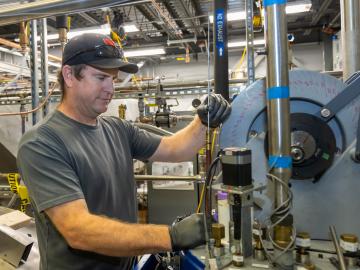Filter News
Area of Research
News Topics
- (-) Advanced Reactors (11)
- (-) Microscopy (13)
- (-) Physics (20)
- (-) Security (11)
- 3-D Printing/Advanced Manufacturing (28)
- Artificial Intelligence (32)
- Big Data (15)
- Bioenergy (20)
- Biology (11)
- Biomedical (14)
- Biotechnology (5)
- Buildings (11)
- Chemical Sciences (9)
- Clean Water (9)
- Climate Change (16)
- Composites (9)
- Computer Science (70)
- Critical Materials (4)
- Cybersecurity (10)
- Decarbonization (16)
- Education (1)
- Emergency (1)
- Energy Storage (19)
- Environment (42)
- Exascale Computing (7)
- Fossil Energy (2)
- Frontier (7)
- Fusion (14)
- Grid (13)
- High-Performance Computing (12)
- Isotopes (14)
- ITER (1)
- Machine Learning (12)
- Materials (11)
- Materials Science (43)
- Mathematics (1)
- Mercury (3)
- Molten Salt (5)
- Nanotechnology (17)
- National Security (12)
- Net Zero (4)
- Neutron Science (37)
- Nuclear Energy (33)
- Partnerships (8)
- Polymers (10)
- Quantum Computing (7)
- Quantum Science (22)
- Simulation (10)
- Space Exploration (9)
- Statistics (2)
- Summit (15)
- Sustainable Energy (21)
- Transportation (30)
Media Contacts

Associate Technician Sean Hollander is the keeper of the Fundamental Neutron Physics Beamline, which is operated by the Physics Division at the Spallation Neutron Source at ORNL, where scientists use neutrons to study all manner of matter.

Researchers set a new benchmark for future experiments making materials in space rather than for space. They discovered that many kinds of glass have similar atomic structure and arrangements and can successfully be made in space. Scientists from nine institutions in government, academia and industry participated in this 5-year study.

Researchers tackling national security challenges at ORNL are upholding an 80-year legacy of leadership in all things nuclear. Today, they’re developing the next generation of technologies that will help reduce global nuclear risk and enable safe, secure, peaceful use of nuclear materials, worldwide.

When scientists pushed the world’s fastest supercomputer to its limits, they found those limits stretched beyond even their biggest expectations. In the latest milestone, a team of engineers and scientists used Frontier to simulate a system of nearly half a trillion atoms — the largest system ever modeled and more than 400 times the size of the closest competition.

Mohamad Zineddin hopes to establish an interdisciplinary center of excellence for nuclear security at ORNL, combining critical infrastructure assessment and protection, risk mitigation, leadership in nuclear security, education and training, nuclear security culture and resilience strategies and techniques.

Scientists at Oak Ridge National Laboratory and six other Department of Energy national laboratories have developed a United States-based perspective for achieving net-zero carbon emissions.

Canan Karakaya, a R&D Staff member in the Chemical Process Scale-Up group at ORNL, was inspired to become a chemical engineer after she experienced a magical transformation that turned ammonia gas into ammonium nitrate, turning a liquid into white flakes gently floating through the air.

An experiment by researchers at the Department of Energy’s Oak Ridge National Laboratory demonstrated advanced quantum-based cybersecurity can be realized in a deployed fiber link.

New computational framework speeds discovery of fungal metabolites, key to plant health and used in drug therapies and for other uses.

Corning uses neutron scattering to study the stability of different types of glass. Recently, researchers for the company have found that understanding the stability of the rings of atoms in glass materials can help predict the performance of glass products.




